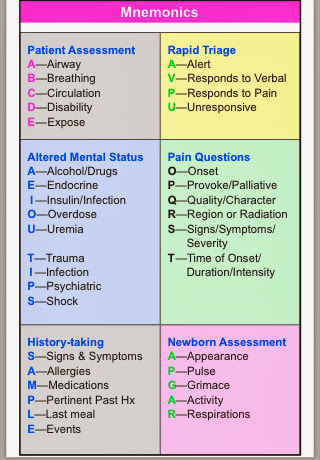As an EMT, you know that the key to providing effective care is having a comprehensive understanding of basic medical procedures and protocols. To that end, we’ve compiled a list of mnemonics to help you remember the most important information when responding to an emergency situation.
Head-to-Toe Assessment
 Remember the acronym DCAP-BTLS when conducting a head-to-toe assessment on a patient:
Remember the acronym DCAP-BTLS when conducting a head-to-toe assessment on a patient:
- D - Deformities
- C - Contusions
- A - Abrasions
- P - Punctures or Penetrations
- B - Burns
- T - Tenderness
- L - Lacerations
- S - Swelling
Medical Emergencies
 When responding to a medical emergency, remember the following:
When responding to a medical emergency, remember the following:
Stroke
Use the acronym FAST to help identify a stroke:
- F - Face drooping
- A - Arm weakness
- S - Speech difficulties
- T - Time to call 911
Heart Attack
To identify a possible heart attack, use the acronym MONA:
- M - Morphine
- O - Oxygen
- N - Nitroglycerin
- A - Aspirin
Breathing Difficulties
When a patient is having difficulty breathing, remember the acronym AEIOU-TIPS:
- A - Alcohol or anxiety
- E - Epiglottitis
- I - Infection
- O - Overdose (narcotics or other drugs)
- U - Uremia
- T - Trauma
- I - Insulin
- P - Psychogenic causes
- S - Seizures or stroke
Trauma Emergencies
 When responding to a trauma emergency, remember the following:
When responding to a trauma emergency, remember the following:
Burns
For burns, use the rule of nines to determine the severity:
- Head and neck: 9%
- Arms (each): 9%
- Torso: 36%
- Legs (each): 18%
- Genitals: 1%
Spinal Injuries
For suspected spinal injuries, use the acronym IMMOBILIZE:
- I - Immobilize the patient
- M - Maintain the position that the patient is found in
- M - Manual stabilization (using your hands to hold the head, neck, and spine in place)
- O - Obtain a cervical collar
- B - Backboard the patient
- I - In-line movement of the patient (keeping the head, neck, and spine in line)
- L - Log roll the patient for transport
- I - Immobilize the patient during transport
- Z - Zipper the backboard (attaching the patient to the backboard)
- E - Evaluate and monitor the patient continuously
Bleeding
When treating bleeding, use the acronym ISABELLA:
- I - Isolate and control the bleeding
- S - Select an appropriate dressing
- A - Apply direct pressure to wound
- B - Bandage the dressing in place
- E - Elevate the wound above the heart
- L - Look for additional bleeding sites
- L - Ligation (if necessary)
- A - Apply and activate a tourniquet
Remembering these mnemonics can help you provide the best possible care for your patients in an emergency situation. Stay calm, stay focused, and always be prepared.